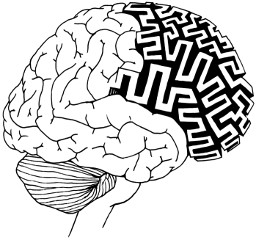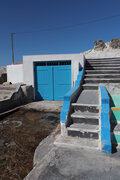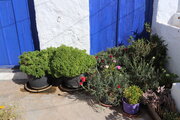
|
AREADNE 2026 Research in Encoding And Decoding of Neural Ensembles Eliopoulos Conference Center Milos, Greece 23–27 June 2026 |

|
We are pleased to announce AREADNE 2026, our 20th anniversary session, will be held Tuesday to Saturday, 23-27 June 2026, at the Elipoulos Conference Center on the Greek island of Milos. If you have been to an AREADNE meeting on Santorini in the past, please note that we have changed locations to Milos.
Sign up for the Google Group for Official AREADNE Announcements to get email sent to you when there is news for the conference.
Site Overview
Introduction
One of the fundamental problems in neuroscience is to understand how the activation of ensembles of neurons gives rise to the higher order functions of the brain including learning, memory, cognition, perception, action and ultimately conscious awareness. Electrophysiological recordings over the past seventy years have revealed considerable information about the firing patterns within networks of neurons that perform these functions, but many mysteries remain.
 Technological advances have provided deep insight into the
global functioning of the brain. These technologies include
multi-microelectrode array electrophysiology, optical imaging and
stimulation, functional magnetic resonance imaging, and genetic
manipulation. These technologies have expanded our knowledge of brain
functioning beyond the single neuron level into the realm of
ensembles.
Technological advances have provided deep insight into the
global functioning of the brain. These technologies include
multi-microelectrode array electrophysiology, optical imaging and
stimulation, functional magnetic resonance imaging, and genetic
manipulation. These technologies have expanded our knowledge of brain
functioning beyond the single neuron level into the realm of
ensembles.
At the same time, our understanding of how neuronal ensembles carry information has allowed the development of brain-machine interfaces (BMI) to enhance the capabilities of patients with sensory or motor deficits. Our knowledge of how neuronal ensembles encode sensory stimuli has made it possible to develop perceptual BMIs for the hearing and visually impaired, while our understanding of how to decode motor intentions has resulted in motor BMIs by which people with severe motor disabilities can control external devices.
Conference Mission Statement
There are three major goals of the AREADNE Conferences. First and foremost, the meetings are intended to gather global scientific leaders who work on neural ensembles and create a touch-point for a widely disparate and hybrid field. Second, with an idyllic setting on Milos, the conferences have been carefully planned to foster discussion and interaction between attendees to encourage the establishment of lasting professional relationships. Third, these meetings continue our efforts to promote systems neuroscience in Greece through creating a world-class forum for cutting-edge research.
Conference Location and Format
 The 2026 conference will take place on the Greek island of Milos from
Tuesady through Saturday, 23-27 June 2026, starting with an informal Welcome
Reception
the evening of Tuesday, 23 June 2026. The
conference will be at
the George Eliopoulos Conference Center
in the town of Adámas; (see photo to the right). The conference will be single-track. Morning talks
will be followed by a working lunch.
After an afternoon break, participants will reconvene for early evening talks
and poster presentations, ending in time for late dinner in accordance
with local customs. Although delegates arrive from around the world,
AREADNE speakers are selected primarily from the United States, Europe, and
the Middle East.
The 2026 conference will take place on the Greek island of Milos from
Tuesady through Saturday, 23-27 June 2026, starting with an informal Welcome
Reception
the evening of Tuesday, 23 June 2026. The
conference will be at
the George Eliopoulos Conference Center
in the town of Adámas; (see photo to the right). The conference will be single-track. Morning talks
will be followed by a working lunch.
After an afternoon break, participants will reconvene for early evening talks
and poster presentations, ending in time for late dinner in accordance
with local customs. Although delegates arrive from around the world,
AREADNE speakers are selected primarily from the United States, Europe, and
the Middle East.
Submission of Poster Abstracts
We anticipate being oversubscribed for 2026 as in previous years, and so strongly encourage anyone who is considering attending the conference to submit a poster abstract. Accepted posters will have one registration reserved for the presenter. Other registration spots will be on a first come first served basis. We are typically able to accommodate only an exceedingly small number of delegates who are not a designated poster presenter.
Abstract submission is anticipated to open on 12 January 2026.
Registration and Fees
 Conference fees have not yet been finalized, but are expected to be
USD 600 for students,
USD 800 for post-docs,
USD 1000 for faculty members or professionals, and
USD 1600 for on-site registrants, space permitting.
On-site fees are considered full price; the other levels are
discounted thanks to the generosity of our sponsors. Registration
fees are payable in USD by credit card.
Conference fees have not yet been finalized, but are expected to be
USD 600 for students,
USD 800 for post-docs,
USD 1000 for faculty members or professionals, and
USD 1600 for on-site registrants, space permitting.
On-site fees are considered full price; the other levels are
discounted thanks to the generosity of our sponsors. Registration
fees are payable in USD by credit card.
Registration fees cover coffee breaks, hot lunches, the Welcome Reception, the Gala Banquet, and an optional excursion. Registration is separate from proposal submission. Conference attendance will be strictly limited. Once registration has filled, a waiting list is established; at previous meetings, only a few people on the waiting list were eventually offered a registration spot. If the conference is full, on-site registrations will not be accepted.
Refund Policy. If you have registered but will be unable to attend, a full refund of paid fees will be given until 26 May 2026, a 50% refund will be given from then until 9 June 2026, and no refund will be given after 9 June 2026.
To be sent an email reminder when registration opens, please add yourself to the Google Group for Official AREADNE Announcements. In previous years, we have sold out just with presenters of submitted abstracts prior to the official opening of registration; in these cases, when we open registration, delegates who are not poster presenters are offered a spot on the waiting list.
Important Dates
AREADNE 2026 will be Tuesday to Saturday, 23-27 June 2026, starting Tuesday evening with a Welcome Reception.
| 2026-01-12 | Abstract submissions open |
| 2026-01-30 | Abstract submissions close |
| 2026-03-03 | Abstract notifications sent (currently delayed) |
| 2026-03-08 | Registration opens (subject to change) |
| 2026-06-02 | Registration closes |
| 2026-06-22 | Suggested arrival |
| 2026-06-23 | Welcome Reception (late PM) |
| 2026-06-24 | Conference opens (early AM) |
| 2026-06-27 | Conference closes (late PM) |
| 2026-06-27 | Gala Banquet (late PM) |
| 2026-06-28 | Suggested departure |
Attendees should plan to arrive in Milos by 23 June 2026 (or the day before, especially for intercontinental travelers), and depart on or after 28 June 2026. We strongly recommend that you do not schedule an important event immediately following the meeting, because of potential travel irregularities as we saw in 2024.
Accommodations
Many hotels are available in and around Adámas. The conference center is located 15 minutes by foot from the center of of town. We encourage conference attendees to follow the lead of the organizing committee, and stay in hotels that are walking distance from the Eliopoulos Conference Center. Plan to arrive by Tuesday, 23 June 2026 if coming from Europe or Monday, 22 June 2026 if traveling intercontinentally, and depart Sunday, 28 June 2026.
We suggest booking your hotel room as early as possible.
Meals
 Daily coffee breaks, lunches, and a Welcome Reception will be provided
at the conference center. Working lunches will be provided on three
of the four days. A Gala Banquet will be held at a local restaurant
on the final day of the conference. These meals are included in the
conference package for participants; guests are welcomed to the
Welcome Reception, and additional tickets are available for purchase
during on-line registration to bring guests to the Gala Banquet.
Daily coffee breaks, lunches, and a Welcome Reception will be provided
at the conference center. Working lunches will be provided on three
of the four days. A Gala Banquet will be held at a local restaurant
on the final day of the conference. These meals are included in the
conference package for participants; guests are welcomed to the
Welcome Reception, and additional tickets are available for purchase
during on-line registration to bring guests to the Gala Banquet.
Breakfasts are typically included in hotel rates, or available with bookings for a nominal charge, and are thus not provided at the conference center. There is a wide selection of nearby restaurants for evening meals, and we anticipate making loosely organized excursions to different restaurants each evening, except the last, when we have the banquet.
Restaurant recommendations are available.
Activities on the island
We are planning an optional boat excursion around the island. This event may not be able to accommodate everyone.
Additional suggested activities are available.
Transportation
 Air transportation to Athens International Airport
(ATH) is available through the major international airlines,
many discount companies, and numerous charter companies. Air
transport from Athens to Milos
(MLO) is available multiple times per day and takes less than an hour. It
is usually possible to arrange flight schedules so that overnight stays in
Athens are not required when connecting to and from Milos.
Air transportation to Athens International Airport
(ATH) is available through the major international airlines,
many discount companies, and numerous charter companies. Air
transport from Athens to Milos
(MLO) is available multiple times per day and takes less than an hour. It
is usually possible to arrange flight schedules so that overnight stays in
Athens are not required when connecting to and from Milos.
Sea passage from Athens to Milos can be a relaxing experience. Ferries for the island leave from the port of Piraeus, about one hour by taxi from the Athens airport, and from the town of Rafina, about 25 minutes by taxi from the airport in the other direction. Rail and express bus transportation are also available from the airport to the ferries in Piraeus.
Getting around on Milos can be done by bus and taxi. Cars and mopeds are readily available for hire. The conference center is located at the edge of the port town of Adámantas (often called just Adámas), and is walking distance to many hotels and restaurants, so having a motorized vehicle is not required.
More transportation information is available here.
Visa Requirements
European citizens have free Schengen access to Greece.
UK citizens have visa-free travel to the Schengen zone (supported by a UK passport) for 90 days out of 180.
United States citizens traveling on regular passports (excluding diplomatic and governmental passports) are currently able to enter the Schengen zone without prior authorization, although that is expected to change in April, 2027 with the introduction of ETIAS (European Travel Information and Authorization System).
Citizens of other countries will need to contact their home governments to determine visa requirements. We are happy to assist with visa letters.
Schedule
 The schedule for the four-day conference follows the Greek lifestyle of
having a long lunch, afternoons free for siestas or swimming, and a late
dinner. To encourage participants to stay for the entire event, the detailed
speaker and poster schedule will not be available until the start of
the conference, even to the speakers and poster presenters.
The schedule for the four-day conference follows the Greek lifestyle of
having a long lunch, afternoons free for siestas or swimming, and a late
dinner. To encourage participants to stay for the entire event, the detailed
speaker and poster schedule will not be available until the start of
the conference, even to the speakers and poster presenters.
All attendees should plan a stay that includes arrival on Milos no later than Monday, 22 June 2026 for intercontinental travelers or Tuesday, 23 June 2026 for those arriving from Europe, and departure no earlier than the following Sunday, 28 June 2026.
Tuesday, 23 June 2026
19:30-22:00 Welcome Reception (light refreshments) and Registration
Wednesday, 24 June 2026
08:00-08:30 Registration
08:30-12:30 Lectures and coffee break
12:30-14:00 Lunch
17:00-21:30 Lectures, coffee break, and poster session
Thursday, 25 June 2026
09:00-12:30 Lectures and coffee break
12:30-14:00 Lunch
17:00-21:30 Lectures, coffee break, and poster session
Friday, 26 June 2026
09:00-13:00 Optional boat excursion
17:00-21:30 Lectures, coffee break, and poster session
Saturday, 27 June 2026
09:00-12:30 Lectures and coffee break
12:30-14:00 Lunch
17:00-19:30 Lectures and coffee break
21:00-24:00 Gala Banquet (full dinner)
By long-standing policy we do not release the detailed speaker or poster schedule before the start of the conference. (Why not?)
Confirmed Speakers
Our confirmed speakers include many global luminaries in the field of Computational and Systems Neuroscience.
| Jaideep Bains | Krembil Institute / University of Toronto |
| Farran Briggs | NIH National Eye Institute |
| Mark Cembrowski | University of British Columbia |
| SueYeon Chung | New York University |
| Brent Doiron | University of Chicago |
| Manolis Froudarakis | University of Crete |
| Julijana Gjorgjieva | Technical University of Munich |
| Michael Hauser | University College London |
| Michele Insanally | University of Pittsburgh |
| Viren Jain | Google Research |
| Mehrdad Jazayeri | Massachusetts Institute of Technology |
| Sheena Josselyn | SickKids / University of Toronto |
| Caleb Kemere | Rice University |
| Jennifer Linden | University College London |
| Atila Losonczy | Columbia |
| Mackenzie Mathis | Ecole Polytechnique Federale de Lausanne |
| Nina Miolane | University of California Santa Barbara |
| Bence Olveczky | Harvard University |
| Stephanie Palmer | University of Chicago |
| Kanaka Rajan | Harvard University |
| Jennifer Raymond | Stanford University |
Moderators
In addition to our expert speakers, we have special session moderators with extensive AREADNE experience to keep the discussions lively and interesting.
Organizing Committee
| Dora Angelaki | New York University |
| Kenny Blum | Harvard University |
| Nicholas Hatsopoulos, co-chair | University of Chicago |
| John Pezaris, co-chair | Harvard Medical School |
| Panayiota Poirazi | Foundation for Research and Technology Hellas |
| Thanos Siapas | Caltech |
| Jiannis Taxidis | University of Toronto |
| Andreas Tolias | Stanford University |
The Myth of Ariadne
 We take the conference name AREADNE from the subtitle, Research in Encoding And Decoding
of Neural Ensembles, combined with the name of the mythological figure Ariadne.
We take the conference name AREADNE from the subtitle, Research in Encoding And Decoding
of Neural Ensembles, combined with the name of the mythological figure Ariadne.
Theseus, an Athenian hero, journeyed to Crete to slay the Minotaur, a half-bull, half-human creature. King Minos of Crete kept the Minotaur at the center of a large maze he built, known as the Labyrinth.
Minos' daughter Ariadne, after whom we've named the conference, gave Theseus a sword and a ball of silk thread, both of which had been given to her by Daedalus, designer of the labyrinth. Theseus tied one end of the thread at the entrance, unwinding the rest as he navigated the Labyrinth, so that after slaying the Minotaur, he could easily escape by following the thread back out.
Practical Information
We have assembled a body of practical information to guide planning for attending an AREADNE Conference.
Και τα λοιπά (Et Cetera)
AREADNE 2026 will be Tuesday to Saturday, 23-27 June 2026, starting Tuesday evening with a Welcome Reception.
The language of presentation for AREADNE Conferences is English.
To be sent important email announcements about AREADNE 2026, please add yourself to the Google Group for Official AREADNE Announcements.
Internet access will be provided at the Eliopoulos Conference Center only to a limited extent. This is a conscious decision to encourage attendees to participate in the conference rather than to be distracted by email and the Web. Internet cafes are readily available in Adámas for emergencies and extended access. The response from attendees on this policy was overwhelmingly positive at all of our previous conferences.
Abstracts of all presentations will be published in the conference book that is provided to attendees during registration, and available as a downloadable PDF after the meeting. Copies from previous meetings are available on our archives page.
We have compiled a list of frequently asked questions.
For additional information on other conference-related topics, please contact the Organizing Committee Co-Chairs, Nicholas Hatsopoulos and John Pezaris, at info@areadne.org.
Photographs on this site were taken on Milos 2022-2025 by John Pezaris (except the satellite view published by NASA), to display the beauty of the island. Click on any of them to view a larger version (and use the BACK button on your browser to return to the previous page). Images are copyrighted by the artist and are used by The AREADNE Foundation with permission.
AREADNE | Email | Search | Archive